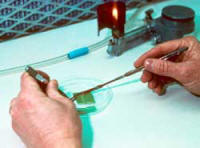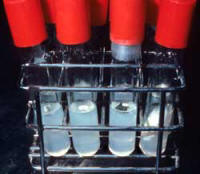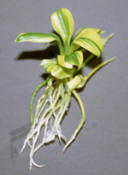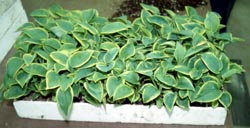One of the things
that has revolutionized the world of hostas in the past
few decades is the introduction of tissue culture (TC)
for the micropropagation of hostas. There seems to be a
bit of mystery associated with TC but, in reality, it is
just a high tech method for making new plants from
cuttings.

We have all taken a
cutting from a geranium plant and put it in moist
potting soil or
perlite to form one new plant. Tissue
culture involves taking a very small piece of a plant
and turning it into hundreds or even thousands of new
copies in a relatively short timeframe.
The difference
between TC and regular cuttings is that this "space age"
technique must be done under totally sterile
conditions. It is called an in vitro process which
means that it takes place in glass. This makes it very
labor and equipment intensive so it is a costly
technique. Therefore, TC is generally used to multiply
plants that are very difficult to propagate with other
more low-tech methods. Or, it may be used to very
rapidly reproduce high value plants where large numbers
are in demand.
Although some of
the specifics will vary from TC lab to lab, the general
process will consist of four stages:
The first three
stages are completed in glass under highly controlled,
sterile conditions. These steps must be highly
controlled in terms of the temperature, light, chemical
and other conditions to assure success. The fourth step
moves out of the laboratory and consists of growing the
plants in regular greenhouse conditions the same as any
other seedlings or cuttings.
_ A. Initiation
of the TC Process
 As
the name implies, this stage is where the whole TC
process gets started. In the case of hostas, a small bud
is usually removed from the crown of the plant to be
propagated i.e. the explant. This bud is delicately
"peeled" back to its smallest point and is cleaned and
disinfected thoroughly.
As
the name implies, this stage is where the whole TC
process gets started. In the case of hostas, a small bud
is usually removed from the crown of the plant to be
propagated i.e. the explant. This bud is delicately
"peeled" back to its smallest point and is cleaned and
disinfected thoroughly.
Throughout the
entire TC process, the constant challenge is to
eliminate any bacteria or fungi which might contaminate
things so all cutting is done with sterilized equipment
and usually in front of a laminar flow hood to prevent
recontamination by fungal spores in the air.
A mixture of plant
nutrients, plant hormones and a jelly-like material
called agar is prepared under sterile conditions and
poured into the bottom of a test tube. The exact
composition of the agar mixture may vary from TC lab to
TC lab. The piece of the explant is carefully placed in
the bottom of the tube nestled on top of the agar
mixture.
The test tubes are
placed on racks in a sterile, growing chamber with
artificial light and strict temperature and humidity
control. People entering this room will be required to
sterilize the soles of their shoes, use medical gloves
and, perhaps, wear a sterile gown to prevent any
contamination. There is nothing more frustrating than
peering into a glass tube and finding grey mold or
bacterial slime instead of nice green plant tissue.
At this point, the
plantlets have no roots so they depend on the sugars in
the agar for energy rather than
photosynthesis.
_ B.
Multiplication of the Plant Tissue
 As
the plant tissue in the test tubes grows and buds
multiply, it needs more room. So, periodically, it is
taken out of the test tube, cut into smaller pieces and
distributed into more tubes. This may be done every 4 to
6 weeks and, again, requires strictly sterile
conditions.
As
the plant tissue in the test tubes grows and buds
multiply, it needs more room. So, periodically, it is
taken out of the test tube, cut into smaller pieces and
distributed into more tubes. This may be done every 4 to
6 weeks and, again, requires strictly sterile
conditions.
Each time the
plantlets are divided and re-tubed, represents the
equivalent of about one year's growth in the garden.
That means that, if one bud on a division in the garden
would put on 4 buds during an entire summer, it would do
the same in the tube in about 4 weeks time. A good
estimate is that each bud will produce as many new buds
in one year as it would in 10 years in the garden. So,
you can see how these plants multiply so rapidly under
TC.
Generally speaking,
two plant hormones are used during TC. One is called a
cytokinin which encourages bud formation and the other
is an auxin that encourages root growth. During the
multiplication stage, the level of cytokinin in the agar
is relatively higher than the auxin because the TC lab
is encouraging buds to multiply and is not yet
interested in forming roots.
_ C. Rooting the
New Plants
 After
several rounds of multiplication have been completed,
the plants will be switched over to an agar mixture that
has a higher level of auxin relative to the cytokinin.
That will trigger the formation of roots on the small
plantlets.
After
several rounds of multiplication have been completed,
the plants will be switched over to an agar mixture that
has a higher level of auxin relative to the cytokinin.
That will trigger the formation of roots on the small
plantlets.
_ D. Growing the
Plants in the Greenhouse
Once the plantlets
have formed adequate root masses, they will be divided
once more and each one will be planting in a container
of potting media. Then, they will be placed in a
standard greenhouse for growing on to a saleable size at
the retail or wholesale nursery. This is called the
ex-vitro (not in glass) phase of the process.
 Why
go to the trouble and expense of tissue culture? Of
course for many plants that multiply easily from
cuttings or come true from seeds, the cost of TC would
be prohibitive. So, it is generally used for the
following reasons:
Why
go to the trouble and expense of tissue culture? Of
course for many plants that multiply easily from
cuttings or come true from seeds, the cost of TC would
be prohibitive. So, it is generally used for the
following reasons:
_ 1. Clone
Production - Since the resulting plants are actually
exact replicates of the original plant, TC is a way to
maintain the precise characteristics of the original
explant. This is vital in reproducing named cultivars of
hostas where it is important that each one be exactly
the same as the original plant.
_ 2.
Difficult to Propagate Plants - TC may be a last resort
option for some plants that do not easily propagate
through standard cuttings, seeds, layering, grafting or
other methods. Of course, the resulting plants will need
to be of high value to justify the cost.
_ 3. Fast
Production - Plants reproduced through TC can be rapidly
multiplied and quickly made available for sale. This is
especially useful for plants with high demand which can
still maintain a decent price level. From a small piece
of a plant, a good lab can turn out hundreds to
thousands of clones in a few short months.
In the earlier days
of hostas, new cultivar introductions almost always
carried a large price tag. This was because that first
plant was the only one of its kind in the world. If it
were a slow growing type, it might take 4 or 5 years to
make 10 to 15 divisions. For a wonderful new plant,
people would often be willing to pay hundreds of dollars
to have one of those rare divisions. In this scenario,
it would take many, many years before the cultivar would
be generally available at a more affordable price for
the gardening public.
With TC, that same
plant would produce many new plants for sale within a
year or two. This larger supply would result in a more
reasonable price tag too.
_ 4. Disease
Free Plants - Because it is done under highly
controlled, sterile conditions, TC may often be used to
produce certified, disease free plants. By using
specific techniques, virus infected plants may often be
propagated with the resulting clones being virus free.
_ 5. Sports -
Hostas tend to be a plant that frequently mutate or
"sport" on their own compared to other plant genera.
Because a variety of growth hormones are routinely used
in TC and since huge numbers of plants are produced in a
short period of time, this tendency is enhanced.
In a population of
say, ten thousand plants of a particular
hosta cultivar,
there may occur dozens of sports. Imagine how many
gardens you would have to visit to observe this
phenomenon in the home landscape environment. With TC,
however, you might have ten thousand plants of the same
cultivar produced by the same lab. During the quality
control inspections of the plants, you are bound to
find...guess what...dozens of sports. Of course, only a
small number of these variations will be worthy of
naming but TC has become a major source of new hosta
cultivars in recent years.
So, why not use TC
to propagate all hostas?
_ 1. Expense
- TC requires a high level of investment in equipment
and highly trained staff. Therefore, it is not
economically viable for every nursery. It is usually
more cost effective for small nurseries or growers to
propagate a plant by some of the older, low-tech methods
which do a good job at a much lower cost.
However, in recent
years, more independent TC labs have come into existence
who only propagate the plants and sell small "plug" size
plants to wholesale and retail nurseries. As a result,
even many of the smaller retail outlets are able to
afford to use TC plants.
_ 2. Sports -
While this can be an advantage with certain species such
as hostas, it can also be a negative when too many,
useless sports result and must be trashed. This factor
is another cost consideration since plants must be
inspected closely at all steps to assure quality.
_ 3.
Sanitation - The specter of fungal infections ruining an
entire environmentally controlled room full of test
tubes hangs heavily over the head of every TC lab.
Extensive efforts must be made to take care in every
step of the process to prevent contamination.
The big question
that has circulated around the hosta world since the
beginning of TC is, "Are tissue cultured plants as good
as those divided from a plant growing in the ground?"
The answer is a resounding, YES! Just like taking a
knife and cutting a part of a hosta crown off to make a
division, TC plants are exactly the same as the mother
plant.

I think some of the
confusion comes from a couple of factors. First, in
their effort to make a quicker return on their
investment, some nurseries sell tiny, little TC plants
in two inch pots. Of course, it may take a year or two
for these to grow to the size of a single division taken
directly from a mother plant.
If for example,
both plants came from an H. 'Sum and Substance' mother
plant, they should both eventually grow to the same
mature size given similar growing conditions. It may
take the TC plant a little longer because it started as
a smaller plant. If the TC plant is grown to a good size
at the nursery before you purchase it, there should be
no difference between it and a similar size hand-made
division.
Another point of
confusion may come from the fact that there are a lot of
sports produced during TC. People seem to think that the
fact that the TC lab has used plant hormones to
manipulate that process that there must be something
"unnatural" about all of the plants produced in this
manner. As mentioned previously, hostas naturally
produce a lot of sports. TC produces many, many plants
in a short period of time and, with the extra hormones,
it accelerates this natural process. The "non-sports"
should be perfectly fine and just exactly like the
mother plant cultivar.



